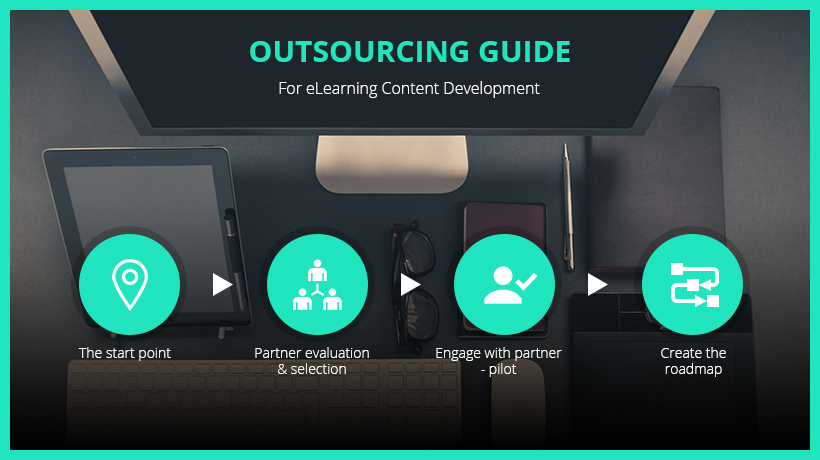
Introduction
Blended learning provides several benefits to both organizations and learners. In this article, I show you how you can manage the transition from a facilitated mode (or ILT) to a blended learning mode in order to design and deliver successful blended learning solutions.
Background
What are Blended Learning Solutions?
As the name suggests, Blended Learning solutions use a combination of facilitated (or Instructor-Led) trainings with online trainings.
They offer an optimal, hybrid approach to deliver trainings to meet the varied corporate training needs and enable organizations to leverage the best of both modes.
They resonate well with today’s multi-generational workforce as they take lesser time and offer more online choices to the learners.
Why Does It Make Business Sense to Adopt Blended Learning?
Instructor-Led Training (ILT) isn’t dying and will continue to be the preferred mode for several trainings.
However, there is a clear shift toward its digitization and this trend will accelerate further.
The value that Blended Learning solutions provide to the organizations:
- Cost reduction.
- Shorter training session duration.
- Ease of scaling.
- Ability to reach a wider audience in a shorter time with a consistent message.
- Ability to update and re-deploy training in a lesser time.
The value that Blended Learning solutions provide to the learners:
- Not all learners learn at the same pace and having a mix of online and facilitated sessions to learn provides optimal environments for them.
- You can offer a wider set of options to the learners through Blended Learning that match their learning styles or learning preferences.
- Blended learning solutions provide accessibility to online resources so that learners can re-visit them, at the moment of their need.
The success of Blended trainings and the impact that this kind of learning solution can bring to the table hinges on how you design the blending of the two components (facilitated or Instructor-Led and self-paced, online training).
At EI, we use three models that are the start point of the transition on how you should blend the two components. Essentially, you have three options to choose from to meet the overall learning outcomes of your training programs:
- Model 1: Significant face-to-face, ILT training with a small component of online training.
- Model 2: An equal mix of face-to-face or facilitated training as well as online training.
- Model 3: Significant online learning with short and focused face-to-face, ILT training.
What Are the Benefits That Blended Learning Solutions Provide to Learners and Organizations?
Benefits of Blended Learning solutions for the learners:
- Learner-centric: Blended Learning solutions align better to the way today’s learners want to learn. Modern learners want to optimize the time spent on training (particularly, away from the desk). They prefer to block lesser time for facilitated sessions and want more flexibility that online resources offer. The online resources can be “pulled” when required, and as many times as required.
- 24×7 accessibility: Blended Learning solutions offer the learning resources online. Additionally, the recordings of the facilitated sessions are also available online. As a result, all resources for Blended Learning are available to the learners 24×7 now.
- Flexibility: The learning resources can be consumed on the go, on the device of learner’s choice.
- Ongoing learning and collaboration: The learning need not stop with the end of the facilitated session. Instead, the learners can continue to have a connect with the instructors as well as their peers post the workshop through online connects. The learning can continue through threaded discussions, exchange of ideas, problem solving, and other areas of collaboration.
Benefits of Blended Learning solutions for the organizations:
- Lower costs: In contrast to the traditional facilitated sessions, Blended Learning solutions need lesser budgets.
- Lesser seat time: They also map to a lower seat time, so the training durations are lesser. (Typically, an 8-hour ILT session will map to 2-3 hours of fully online session).
- Scale and reach a wider audience: They enable organizations to scale the training quickly and reach out to a geographically spread out workforce at the same time.
- Consistent message: Unlike the facilitated session, where the impact of the training is driven by the quality of the trainer, the online components of the Blended training ensure that a single, consistent message is delivered.
- Leverage on facilitated sessions and reuse: Additionally, you can convert the facilitated sessions into online resources, and this can be re-used at no additional cost.
How Can You Design Blended Learning Solutions for Success?
The key to success lies in handling the transition correctly from a successful and established facilitated or ILT program to a Blended mode.
To achieve this, you need to be aware of some of the associated challenges and ensure that these are handled, therefore mitigating the risks. The list of the key challenges is listed first and then I share a guide or a toolkit that you can use to handle them.
- Not quite sure on where to begin.
- No buy-in from senior stakeholders.
- Lack of adequate resources to manage the transition.
- Often, trainers may not be convinced on the need to move the ILT mode to fully online or Blended mode. However, their support is very critical in ensuring the success of the Blended Learning solution.
- One size does not fit all and what approach (that is, what degree of blend) is required is not obvious and isn’t easy to identify.
At EI, our practice of Blended training design is driven by a Step-by-Step Guide or our Blending Learning Toolkit. You can use these pointers as you embark on moving to a Blended Learning mode.
Step 1: Identify your reason to opt for a Blended Learning solution
- What are the factors that are triggering the need to transform the training format?
- Is the new format expected to address any specific challenges that were not being addressed by the facilitated format?
- What are the expected gains from the new format?
Step 2: Validate the effectiveness of the new approach (to arrive at the degree of blending and the impact it would create)
- Would the learners be amenable to adopting the revised delivery format?
- Would the learners get a better learning experience?
- Would the program mandate be met?
Step 3: Identify the support required (for delivery and for instructors and learners)
- Evaluate the options for delivery including:
- The platform to offer VILT and LMS to offer online training.
- The support for instructor and learners so that they can maximize the value of the new format.
Step 4: Identify the support required to handle change management effectively
- Begin with the measures to ensure that you have the buy-in of the senior stakeholders (from L&D as well as from business units).
- Also, ensure that the instructors are aligned to support the transition.
- Poll the learners to be certain that they see the required value.
Step 5: Review the existing content to determine its suitability to adapt to a blended delivery
- You need to do an effective mapping of classroom-based activities and exercises to the online format. While some of them would find a direct match to the interactive activities in the online mode, some may require a selection of alternative formats.
- You also need to update the initial assessment strategy after identifying how it can be adapted to a Blended delivery. For instance, given the ease of tracking online assessments, you could move the entire assessment (of both facilitaed as well as online components) to an online mode.
Step 6: Once these measures are in place, you are ready to go and are poised for success
- Create the Blended training program design.
- Create an approach plan to implement the Blended training program as follows:
- Plan for a pilot.
- Take feedback.
- Re-deploy.
- Feedback and further improvement: Arriving at the right degree of a Blended Learning solution is a combination of art and science. Feedback from learners as well as business units will help you fully align to your mandate. After the initial roll-out, seek feedback from learners as well as business units to assess if the program was successful. These cues can be used to update the mode of delivery (the way you had Blended it).
I hope this article provides the required insights on why you should adopt Blended Learning and, more significantly, how you can plan your transition from facilitated or ILT sessions to a Blended mode successfully.
If you have any specific queries, do contact me or leave a comment below.
Read More
- A Complete Guide On Blended Learning Solutions
- Tips And Best Practices To Create Highly Effective Blended Training Program Design
- ILT To Blended Or Online Training Transformation – Featuring 5 Examples
- 5 Examples On How To Convert Induction And Onboarding Program To Blended Or Fully Online Training
- Free eBook – Your Step-By-Step Guide To Design High-Impact Blended Training Programs – Featuring 7 Success Stories



